Making homemade cream cheese is so easy! You can use this plain cream cheese for bagels, baking, and savory recipes.

Table of Contents
Homemade Cream Cheese From Scratch
I love cream cheese; it has been the salvation of many of my favorite meals. Making homemade cream cheese came about because one year I decided to cook a dish every week that included one specific ingredient, and I chose cream cheese.
When I announced my intentions on Twitter, I got a reply back from Michael Ruhlman, a cook and author, who believes the world is a better place when we cook our own food and share it with the people we love. So I was inspired to look up how to make cream cheese at home.
Homemade Cheeses
Many fresh cheeses – that is, cheeses that don’t have to be aged – you can make at home. Often it is simply a matter of adding lemon juice to milk and letting it sit on the counter for 12 to 24 hours – voila, homemade ricotta!
Leave the curds to grow a little more, and you have farmer’s cheese. This type of cheese is wonderful for breakfast. Spread it some on some toast, and you have a really tasty start to your day.
Why Homemade Cream Cheese Is Worth It
You may ask, why would you make your own cream cheese? Basically, you don’t do it because it is more economical.
The real reason to make your own cream cheese is to enjoy crafting your own cheese. It’s so satisfying and isn’t hard. The final product you get is a wonderful homemade organic cream cheese that tastes rich and tangy.
When you make DIY cream cheese from scratch, you have total control over the ingredients. Plus you don’t have to be concerned with a cream cheese shortage.
DIY Cream Cheese is Easy!
You will be really amazed at how easy it is to make homemade cream cheese. This would be a fantastic project for kids, there is very little measuring.
Ingredients to Make Your Own Cream Cheese
- Half and half
- Mesophilic culture
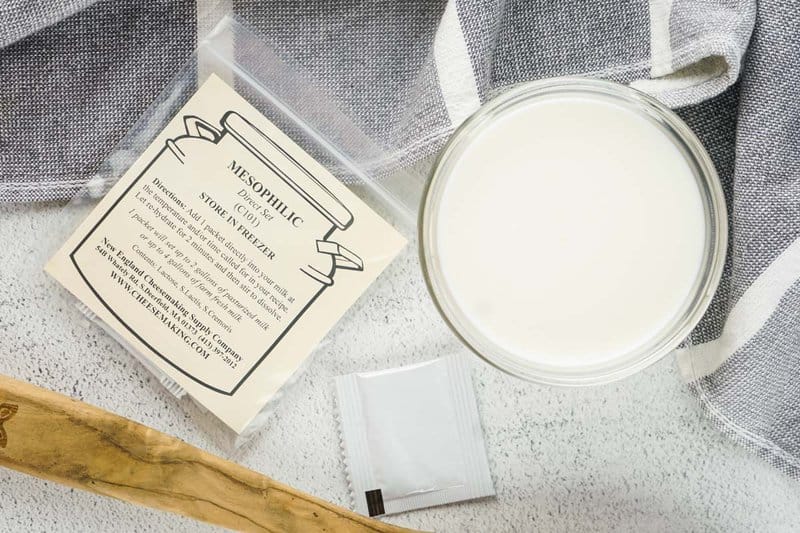
Ingredient Notes
Mesophilic culture is a mix of different bacteria and enzymes. I don’t know of any substitute for this for making homemade cream cheese.
You can use up to 2 gallons of half and half for this homemade cream cheese recipe. You do not need to increase the amount of the culture.
I have not made this recipe with heavy cream, whole milk, skim milk, or any other type of milk. I can’t speak to if that would work for those types of milk products.
Supplies & Equipment Needed for DIY Cream Cheese
For your adventure in making homemade cream cheese, you do need some supplies:
- Butter muslin (also called butter cloth), has a finer weave than cheesecloth. It is used to drain the whey from the cheese. Or you could use a flour sack towel.
- You will need a flat, shallow container. I used a 9 X 13-inch baking pan.
How to Make Homemade Cream Cheese
- Allow your half and half to reach room temperature. Your cheese will set more quickly if it isn’t refrigerator chilled when you add the starter culture.
- Add half and half to a large container. I recommend using a 9×13-inch baking dish.
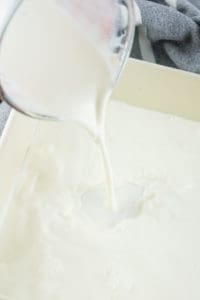
- Add the culture, sprinkling it over the top. Let it sit for about two minutes.
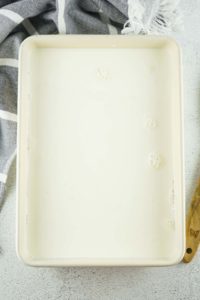
- Give the mixture a good stir with a spoon.
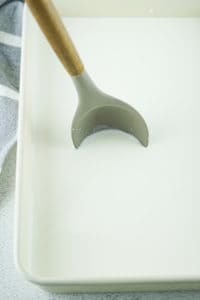
- Place some plastic wrap over the top of the dish and let it set on the counter for anywhere from 8 to 12 hours. When the cream cheese is set, it will have the texture of yogurt. It will appear to you that the whole process isn’t going to work, but here is where you wait and be patient. It can take about 10 to 12 hours for the cream cheese to set in a cooler house, so be patient.
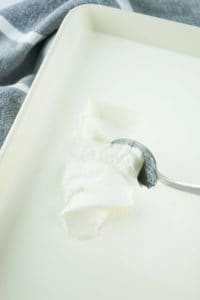
- Place the soft cream cheese into a double-layered butter muslin.
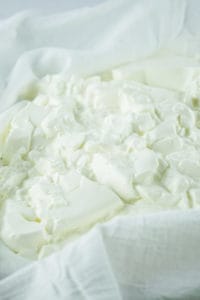
- Gather up the cloth and twist the top. Hant it to let the whey liquid drain out of it for up to 12 hours.
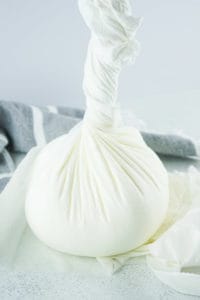
- Once the whey has drained, it will have the density and texture of store-bought cream cheese.

- Transfer the cream cheese to an airtight container or press it into a block.
- Serve it in a bowl or as a block on a tray with crackers or bagels.
This recipe makes 8 to 10 ounces of cream cheese.
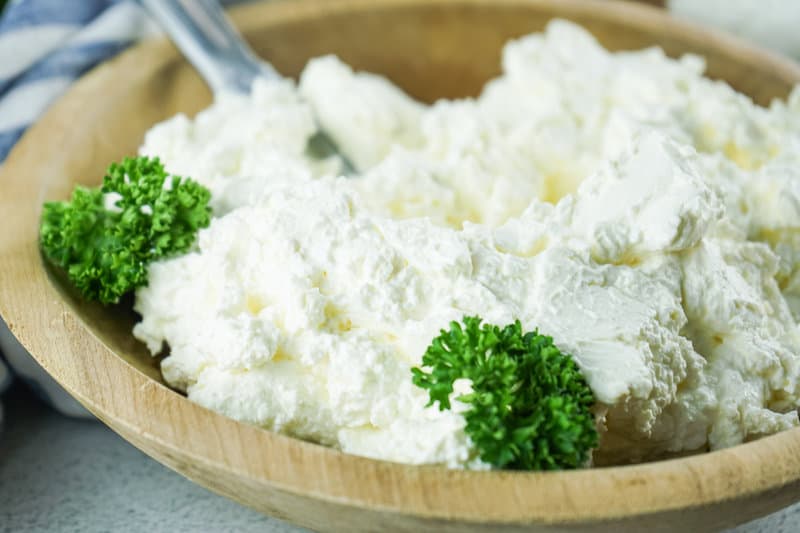
Homemade Cream Cheese Variations
Once you have your delightful homemade cream cheese, you can package it into smaller containers.
- Stir in some chives or herbs for various flavors.
- Stir in jam for a nice treat for breakfast.
- Add honey, cinnamon, and walnuts for a sweet creamy taste.
- Serve it covered in Jan sauce for an appetizer.
- Combine with smoked salmon or lox for a classic taste.
- You can add a little salt if you like. Cheese salt or pickling salt works best as both have finer grains than regular table salt.
Best Ways to Enjoy Homemade Cream Cheese
Cream cheese is perfect for that tasty schmear on your bagel, the best part of your carrot cake with cream cheese frosting, cheesecake, or the creamy cheese ingredient in dip recipes.
Don’t forget your Everything Bagel Seasoning!
How long will cream cheese from scratch last?
Store the cream cheese in an air-tight container in the fridge where it will be good for a few days.
Can you freeze cream cheese?
Yes, you can. However, the texture will change dramatically, so you probably wouldn’t want to spread it on your morning bagel. Cream cheese from the freezer is best reserved for baking or any other use where its grainy texture won’t be noticeable, such as in casseroles.
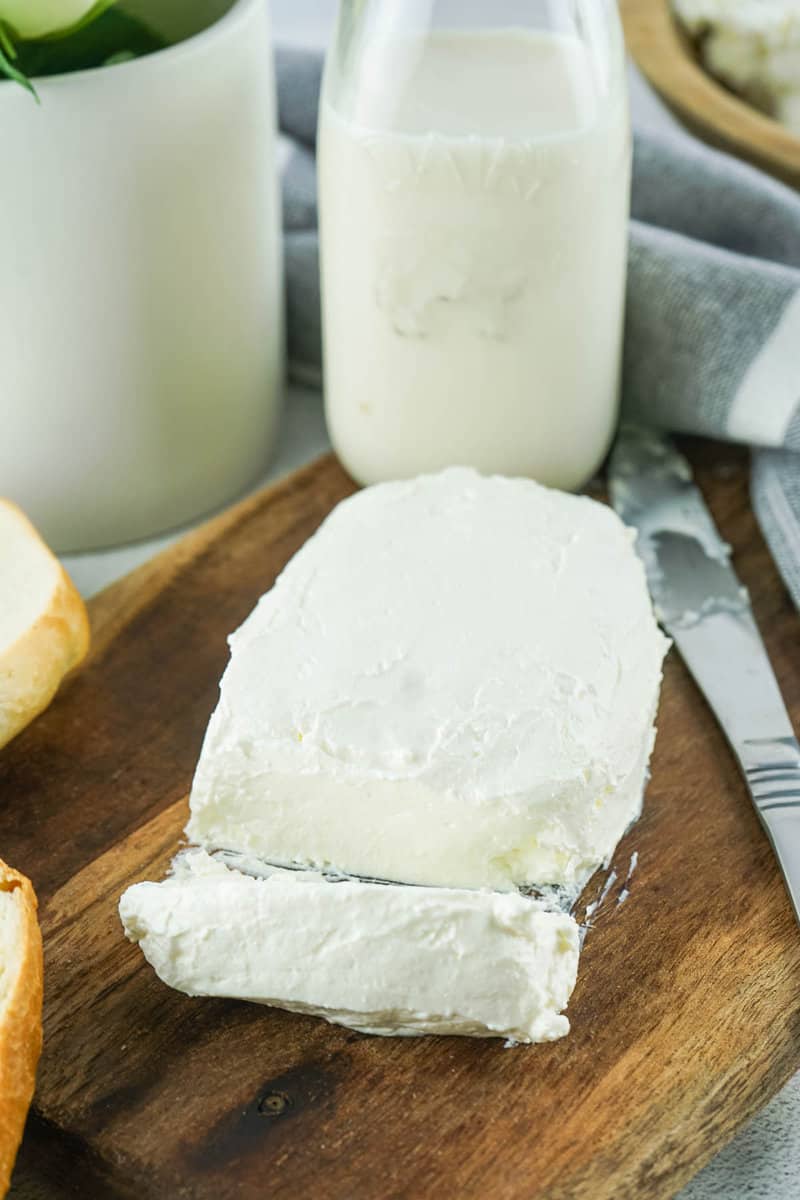
Homemade Cream Cheese FAQ
Is it cheaper to make your own cream cheese?
You may ask, why would you make your own cream cheese? Basically, you don’t do it because it’s more economical. However, if you are into organic eating, organic cream cheese is pricy, so making your own cream cheese from scratch isn’t quite as expensive.
What is the main ingredient in cream cheese?
Cream cheese ingredients are very simple, and you only need two! The main ingredient in this cream cheese recipe is half-and-half, to which you add a culture.
Can you use regular milk or skim milk to make cream cheese?
Yes, you can, but keep in mind that skim milk is better suited to making hard cheeses such as parmesan and romano. When making cream cheese, skim milk will not give you that rich and creamy cheese taste you expect from cream cheese.
What culture do you need to make homemade cream cheese?
The culture used in this cream cheese recipe is mesophilic culture.
What is mesophilic culture?
Mesophilic culture is a cheese culture best suited to work in moderate temperatures, i.e., half-and-half that is neither too hot nor too cold. It provides the proper bacterial organisms to turn half-and-half into wonderful homemade cream cheese.
Can I make cheese with yogurt or buttermilk?
Yes, you can, but it’s not recommended for a novice cheesemaker. There is some overlap between the bacteria in the mesophilic culture and the bacteria in yogurt and buttermilk. You can produce a variety of cream cheese recipes, but they won’t be the same as this one.
Would it spoil the cheese if the room is warm in the summertime?
Your homemade cream cheese will be ok with temperatures of 65 to 75 degrees Fahrenheit.
Can I make cheese with yogurt or buttermilk?
Yes. Yes, you can. Here is why I don’t entirely recommend it for the novice. Actually, you can try to make it with the ambient bacteria in the air, it could turn out, but most likely it will fail. This is how it was originally discovered thousands of years ago. Over time our ancestors realized you could reproduce it by using whey as a starter and they would get more dependable results.
I personally think if you are trying this for the first time you should spring a couple of bucks for culture and get dependable results. I looked up the bacteria that are in both mesophilic culture and buttermilk. They are as follows.
Mesophillic culture may contain lactose, lactococcus lactis subsp. lactis, lactococcus lactis subsp. cremoris
Buttermilk may contain lactose, (LL) lactococcus lactis subsp. lactis, (LLC) lactococcus lactis subsp. cremoris, (LLD) lactococcus lactis subsp. biovar diacetylactis, (LMC) leuconostoc mesenteroides subsp. cremoris.
Yes, there is some overlap. As you can see they are not the same, so sure you will produce a type of cream cheese but isn’t the recipe that I am sharing.

Best Ways to Enjoy Home Made Cream Cheese
Use homemade cream cheese in these recipes:
- Blueberry Cream Cheese Pie
- Clam Dip with Cream Cheese
- Cream Cheese Chicken
- Cream Cheese Wontons
- Grape Salad with Cream Cheese
- Honey Walnut Cream Cheese Spread
- Lemon Cream Cheese Pie
- Sausage Cream Cheese Dip
- Smoked Cream Cheese
- Strawberry Cream Cheese
- Zucchini Cake with Cream Cheese Frosting
Popular DIY Recipes
- Everything Bagel Seasoning
- Homemade Boursin Cheese
- Homemade Garlic Aioli
- Instant Pot Beef Bone Broth
Check out more of my easy dessert recipes the best DIY recipes here on CopyKat!
Homemade Cream Cheese
Ingredients
- 2 quarts half and half
- 1 package mesophilic culture
Instructions
- Pour half and half into a large flat container, like a 9 x 13-inch baking pan.
- Sprinkle mesophilic culture into half and half. Wait about two minutes for the culture to bloom, then stir in the culture.
- Seal the baking dish with plastic wrap. Leave the milk mixture outside on the countertop for about 8 to 12 hours, or until it begins to set up.
- The cream cheese has set up properly when it has the consistency of Greek yogurt.
- You will want to fold over the butter muslin so the fabric is double layered. Place the soft cheese into the butter muslin and hang it so the whey drains out. It may take up to 12 hours for the whey to drain out.
- Once the whey is drained out, transfer the cream cheese to an airtight container. You can serve it as-is or form it into a block.
- Store the cream cheese in the refrigerator.


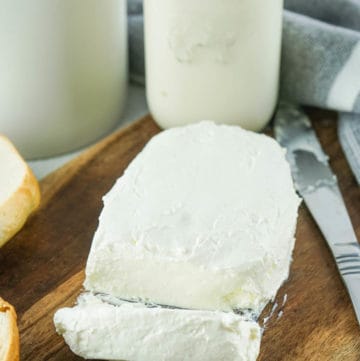
Terriann
Have you made mozzarella cheese? I’m going to try it now I have another cheese to try thank you
AmatureCook
Is there an expiry date?
Deborah
Oh–thank you so much! Have you tried goats milk?
Sorry so many questions–I really want to try this!
Connie
Hi. Do you strain the cream cheese inside the refrigerator or on the counter top? How do you get milk that is not uht? Ca not wait to make our recipe for cream cheese. Love the pictures – very helpful.
stephaniemanley
I strain mine out on the counter. It could work in the fridge as well. I often find the less expensive brands of milk are not UHT, so they will work as well.
Nutmeg Nanny
Hello delicious! So simple!
lyris
I love cream cheese and I can’t wait to start making my own.
stephaniemanley
Let me know how it goes.
Sarah
How does it taste in comparison with store bought cream cheese? I just tried making cream cheese from a different recipe that used 4 cups half and half and 1 cup whipping cream (in cream form, of course… not whipped). And then I used buttermilk as the mesophilic culture. I found that it didn’t have the cream cheese taste at all, and I could tell it had whipping cream in it. I want to try your recipe, but I don’t want to be wasting my time if I’ll never get the taste of the store bought cream cheese. I don’t know what makes it taste the way it does. I just loooooooove store bought cream cheese!
stephaniemanley
Does it taste like philly brand cream cheese, no. It’s pretty good though, I like it fairly well. It comes close to the store bought cheese.
Ashley Teixeira
How close? Id like to make my own to use with cheesecake but not sure how itd work
Stephanie Manley
I would not use it as regular philly brand cheese. I would use this for a cheesecake recipe that uses ricotta cheese.
Terri Hamilton
I made some had couple mishaps with cheesecloth but I love love cream cheese When , was pregnant with my daughter 44yrs ago I craved it Peeled foil back ate it like a candy bar But I thought it tasted remarkably close I was surprised how much mine and Philadelphia tasted the same Hers sounds so much better But totally agree with buying the culture I’ve had to many mistakes with trying to make cheese by not using whats really needed We have nowhere to buy it I get mine cheese making supplys from Amazon I found they was most reasonable priced One thing I’ve learned you’ll always get something you can use you’ll never waste your milk Might be lotta ricotta but I’ve sure ended up with lots Some have been amazing because of my mishaps Shes right try it especially at my store a brick is $3 You’ll get alot more I added a bit of lemon juice to one of mine Made fabulous cheese cake
NikL
Do you know if this will work with lactose-free milk? I can’t stand soy cream cheese (shudder) and no matter how much Lactaid I take, items with cream cheese still really upset my stomach. I’ve found lactose-free yogurt (which is very good) but no cream cheese, so I thought I’d try making my own. Think it would work?
stephaniemanley
I haven’t tried this with lactose-free milk. I would definitely give it a try.
Julie
Cheese making, as well as yogurt making, involves cultures that convert the lactose in milk into lactic acid. If you let the cheese sit long enough before draining you will achieve a cheese with little to none lactose in its final form. Hope this helps!
Yehh
… Whats half and half? branded names do not help whats different about it to other milk? – UK
juderobin
1/2 light cream & 1/2 milk, not a brand but a mixture (often used in coffee)
Samuel Alaoui Abdallaoui
haha where can i find that Mesophilic powder, if those are bacterias , can i collect them from air ?
can you send me a sac of it ?
stephaniemanley
You need to purchase it from a cheese making shop there are many online.
Michelle Manske
First of all you need to make sure your readers know that the type of mesophilic bacteria you used has rennet already in it! This recipe will not work unless you use rennet and most mesophilic bacteria does not come preequiped with rennet! You can easily substitute BUTTERMILK for the mesophilic bacteria. use about an 1/8 cup cultured buttermilk for each gallon of half and half and 1/2 of a tablet of Rennet dissolved in 2 tbsp warm water. You also should be using anything but ULTRA pastorized milk or half and half you are using a product that has nothing live left in it so you get a subpar at best result! It makes a big difference when you use the correct ingredients.
Joseph Pessin
According to this link, Kraft Philadelphia Cream Cheese only uses cultures and no rennet, Are you saying that is not correct?
http://www.natural-connection.com/resource/tnc_reference_library/cheese.html
stephaniemanley
I have found decent results with using the ultra pasteurized milk before. I also do not use rennet in making this cream cheese. I followed the guidelines as listed from http://www.cheesemaking.com, and reading up on my old Readers Digest Back to Basics book. So I feel comfortable with the cream cheese made without rennet.
Some brands of cream cheese do contain rennet. Not all brands of cream cheese contain rennet. It is not necessary for cream cheese to contain rennet.
http://blog.fooducate.com/2011/04/05/10-things-to-know-about-rennet-its-in-your-cheese/
Typically rennet is used in cheeses that are aged for a longer amount of time, and not always used in softer cheeses.
http://www.cheesemaking.com/store/pg/244-FAQ-Cheesemaking-and-Rennet.html
I like mesophillic culture it produces a blend cream cheese, it contains the following bacteria lactose, lactococcus lactis subsp. lactis, lactococcus lactis subsp. cremoris
Buttermilk may contain lactose, (LL) lactococcus lactis subsp. lactis, (LLC) lactococcus lactis subsp. cremoris, (LLD) lactococcus lactis subsp. biovar diacetylactis, (LMC) leuconostoc mesenteroides subsp. cremoris.
Yes, there is some over lap. As you can see they are not the same.
Sure, you can use buttermilk and yogurt, but you don’t know what culture the producer used to prepare his buttermilk or yogurt from. You also don’t really know how fresh it is, and if something is going to turn off. It may work, I will give you that. Why I like to start from a starting culture is that you know what is in your culture, and it isn’t a mystery. You will get known results.
http://www.cheesemaking.com/store/pg/240-FAQ-Cheesemaking-and-Ripening.html
Do I get that using other ways will work, yes. Do I recommend this to someone who has never made this before, no.
Bobby
question, if my first attempt at cream cheese came out not as smooth as i would have liked and not crumbly but somwehat slightly crumbled, does that mean to much whey drained out of it?
stephaniemanley
You could have tried draining it a little longer. You could also run it through a food processor to change the texture.
Jean
I”m puzzled. If you leave liquid pre-cheese dairy product on your kitchen counter (I mean, your milk/culture that is ripening into cream cheese), it can also attract bacteria in the air that you don’t want, and that can in fact make you ill. How do you prevent this? I once had home-made farmers’ cheese, and had a really severe case of food poisoning. I suppose that covering the ripening mass with plastic wrap and then refrigerating will prevent this, but then, will the mixture ripen? You mention letting it sit our on your kitchen counter for 10-12 hours. That’s the worrisome step.
Stephanie Manley
You cover it with plastic while it is fermenting, if you watch the video that’s what I did.
Emily
Do you add salt to your finished product? Can’t wait to try it out!
Stephanie Manley
You can add a little if you like. I will add a little cheese salt, or pickling salt, both are a finer grain than regular table salt.
Stan
Is this like yogurt, where I can use some of the old cream cheese as a culture starter for the new cheese?
stephaniemanley
I haven’t tried this yet, but I am thinking this would work well. I need to try it the next time I make it.
LauraB
Hi Stephanie, I saw below that you suggest Mesophilic(DS) http://www.cheesemaking.com/store/p/135-Mesophilic-DS-5pack.html
However, another site suggests you use Mesophilic(A) http://www.leeners.com/cheese/store/1414.shtml
Is there a huge difference? Will either yield similar results?
Anonymous
Honestly, I am not not aware of the differences between to two mesophillic strains. I would guess there are some slight variations in the flavor between the two. I have not made any purchases from leeners to know what theirs would be like.
LauraB
Thank you Stephanie for the quick reply. I am excited to make this. Great recipe and its seems so simple and yet so gratifying!
Stephanie Manley
Which culture did you try?
Cheryl Kohan
If only I weren’t lactose intolerant….~sigh~. I would SO love this.
Laura Hagan
try using raw milk. I have a friend..her daughter goes into anaphylatic shock with dairy…especially store bought milk & cheese…however her daughter can have raw milk and cheeses made from raw milk
Katie Kearns
The bacteria eat the lactose — homemade cream cheese (and yogurt) end up nearly lactose free, if you leave it out long enough. :> That’s why I started making it. 🙂
N_abeydeera
Sounds so simple ! Let me try it asap. Thx for this great recipe.
WShera
how do you store it once its been made to cream cheese
Anonymous
I store it in the refrigerator in a covered container.
Lockwoodmom
where can I purchase the culture?